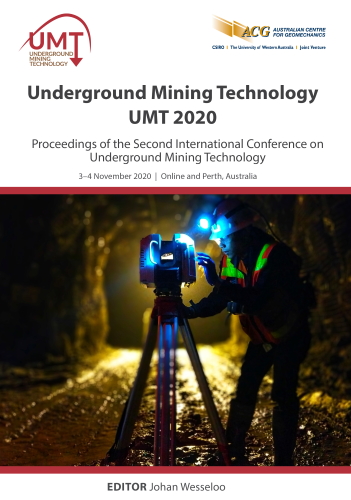Reliable automatic processing of seismic events: solving the Swiss cheese problem

|
Authors: Törnman, W; Martinsson, J |
DOI https://doi.org/10.36487/ACG_repo/2035_04
Cite As:
Törnman, W & Martinsson, J 2020, 'Reliable automatic processing of seismic events: solving the Swiss cheese problem', in J Wesseloo (ed.), UMT 2020: Proceedings of the Second International Conference on Underground Mining Technology, Australian Centre for Geomechanics, Perth, pp. 155-172, https://doi.org/10.36487/ACG_repo/2035_04
Abstract:
BEMIS (Bayesian estimation of mining-induced seismicity) is a fully automatic, near real-time, robust and self-learning seismic processing solution for mining-induced seismic events. A prototype solution is tested in parallel with IMS’s routine manual processing in LKAB’s underground mines in Malmberget and Kiruna, providing four times more accurate earthquake locations based on 290 known blasts, 40 times faster processing time that scales with computer power, and the ability to detect and locate up to six times more events given the same input data. In addition to a fully automatic system, BEMIS provides a variety of unique functions such as quality control of all results, self-learning adaptation and calibrations, tomography, and prediction models of future seismicity. In this paper, we summarise the results from different investigations throughout time and discuss the unique approach considered to obtain reliable auto-processing in a challenging, unknown and changing environment.
Keywords: mining-induced seismicity, automatic processing, statistical seismology, reliable seismic parameters
References:
Brune, J 1970, ’Tectonic stress and the spectra of seismic shear waves from earthquakes’, Journal of Geophysical Research, vol. 75, issue 26, pp. 4997–5009.
Gelman, A, Carlin, JB, Stern, HS, & Rubin, DB 2004, Bayesian Data Analysis, 2nd edn, Chapman & Hall/CRC, London.
Harris, PH & Wesseloo, J 2015, mXrap, version 5, computer software, Australian Centre for Geomechanics, The University of Western Australia, Perth, www.mxrap.com
Kay, S 1993, Fundamentals of Statistical Signal Processing: Estimation Theory, volume 1, Prentice Hall, Upper Saddle River.
Kruschke, J 2014, Doing Bayesian Data Analysis: A Tutorial Introduction with R, JAGS and Stan, 2nd edn, Elsevier Science, London.
Martinsson, J 2012, ‘Robust Bayesian hypocentre and uncertainty region estimation: the effect of heavy-tailed distributions and prior information in cases with poor, inconsistent and insufficient arrival times’, Geophysical Journal International, vol. 192, issue 3, pp. 1156–1178.
Martinsson, J & Jonsson, A 2018, ‘A new model for the distribution of observable earthquake magnitudes and applications to b-value estimation’, IEEE Geoscience and Remote Sensing Letters, vol. 15, issue 6, pp. 833–837.
Martinsson, J & Törnman, W 2019, ‘Modelling the Dynamic Relationship Between Mining Induced Seismic Activity and Production Rates, Depth and Size: A Mine-Wide Hierarchical Model’, Pure and Applied Geophysics, vol. 177, pp. 2619–2639.
Nordqvist, A & Wimmer, M 2016, ‘Holistic approach to study gravity flow at the Kiruna sublevel caving mine’, Proceedings of the Seventh International Conference and Exhibition on Mass Mining, The Australasian Institute of Mining and Metallurgy, Carlton, pp. 401–414.
Nordström, E, Dineva, S & Nordlund, E 2020, ‘Back analysis of short-term seismic hazard indicators of larger seismic events in deep underground mines (LKAB, Kiirunavaara mine, Sweden)’, Pure and Applied Geophysics, vol. 177, issue 2, pp. 763–785.
Pintelton, R & Schoukens, J 2001, System Identification: A Frequency Domain Approach, Wiley-IEEE Press, Piscataway.
Wettainen, T & Martinsson, J 2014, ‘Estimation of future ground vibration levels in Malmberget town due to mining-induced seismic activity’, Journal of the Southern African Institute of Mining and Metallurgy, Johannesburg, vol. 114, pp. 835–843.
Sjöberg, J, Dahnér, C, Malmgren, L & Perman, F 2011, ‘Forensic analysis of a rockburst event at the Kiirunavaara Mine – results and implications for the future’, in D Sainsbury, R Hart, C Detournay & M Nelson (eds), Proceedings of the 2nd International FLAC/DEM Symposium, Itasca International Inc., Minneapolis, pp. 67–74.
Troll, VR, Weis, FA, Jonsson, E, Andersson, UB, Majidi, SA, Högdahl, K…& Nilsson, KP 2019, ‘Global Fe–O isotope correlation reveals magmatic origin of Kiruna-type apatite-iron oxide ores’, Nature Communications, vol. 10, 10.1038/s41467-019-09244-4
Vallejos, J & McKinnon, S 2011, ‘Correlations between mining and seismicity for re-entry protocol development’, International Journal of Rock Mechanics and Mining Sciences, vol. 48, issue 4, pp. 616–625.
Vatcher, J, McKinnon, S & Sjöberg, J 2015, ‘Developing 3-D mine-scale geomechanical models in complex geological environments, as applied to the Kiirunavaara mine’, Engineering Geology, vol. 36,
Vatcher, J, McKinnon, S & Sjöberg, J 2018, ‘Rock mass characteristics and tomographic data’, Rock Mechanics and Rock Engineering, vol. 51, pp. 1615–1619.
© Copyright 2025, Australian Centre for Geomechanics (ACG), The University of Western Australia. All rights reserved.
View copyright/legal information
Please direct any queries or error reports to repository-acg@uwa.edu.au
View copyright/legal information
Please direct any queries or error reports to repository-acg@uwa.edu.au
